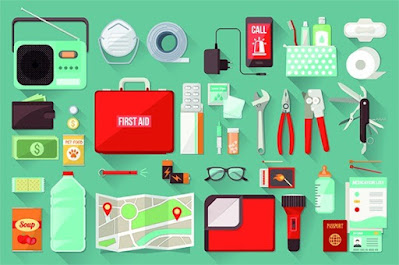It is important to be prepared for an emergency as preparation helps to:
- Reduce fear & anxiety
- Increase the likelihood of survival & healthy outcomes
- Adjust to limited resources during times of disaster.
Your personal emergency kit should contain essential items that you cannot live without. Items should be placed in a sturdy, durable container & kept in a place that is easily accessible in your home. Let’s pack an emergency preparedness kit that you can use at home or take with you in case of evacuation!
Building a Personal Emergency Kit
Your emergency preparedness kit should include:
- Water – pack a minimum of 72 hours of fresh water
- Food – 72 hours’ worth of non-perishable food items
- A flashlight or light sticks
- Extra batteries – for flashlight, radio, breathing devices, cochlear implants, cell phones, hearing aids, etc.
- Battery-operated or hand crank radio
- First aid kit
- 7-day supply of Rx medications
- A Whistle or other signaling device – something to capture attention in your direction
- At least one change of clothing – it is recommended to have protective clothing and a pair of sturdy shoes
- A blanket(s)
- Cash – do not count on credit and debit cards during times of emergency
- Cell phone and charger
- Personal hygiene items – deodorant, soap, sanitary pads, etc.
- Other disability specific equipment – cane, walker, eyeglasses, etc.
- Copies of important documents – birth certificate, passport, insurance policies & medical information
- Family and emergency contact information
Two important documents to include in your kit are the Emergency Information List and a Medical Information & Supply List. Both are available for download from Emergency Preparedness Workbook for People with Disabilities, pages 9 & 10. These documents will help to identify personal medical needs and can also help keep you in touch with those in your personal network.
Additional supplies to consider:
- Anti-bacterial wipes, plastic bags, garbage bags to assist with clean up
- Multi-purpose tool
- Duct tape
- Pet food & extra water for your pet {our next emergency preparedness eblast will be instructions on prepping your pet}
- Sleeping bag
- Fire Extinguisher
- Pencil and paper
- Local maps
- Can opener
- Books, games, puzzles – for kids and adults!
There are many helpful resources available online. For additional tips and guidelines, visit SCEMD, Family Emergency Kit or Red Cross, Survival Kit Supplies.
Sources:
- Emergency Preparedness Workbook for People with Disabilities
- SCEMD, Family Emergency Kit
- Red Cross, Survival Kit Supplies


No comments:
Post a Comment